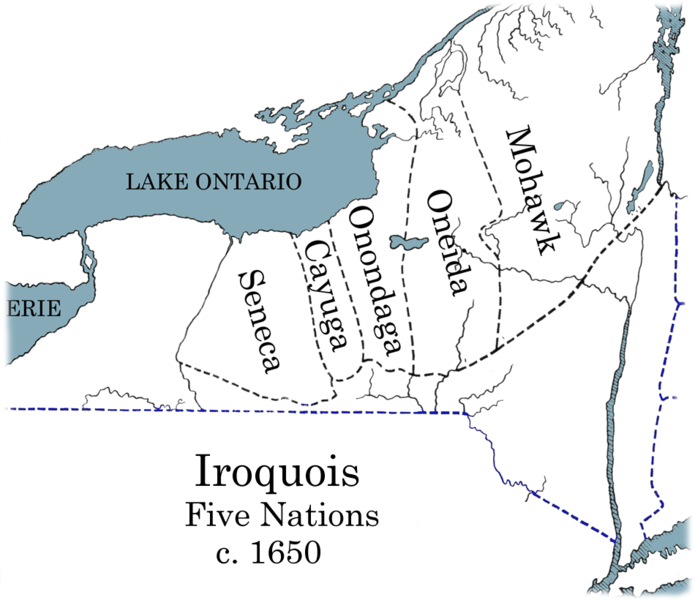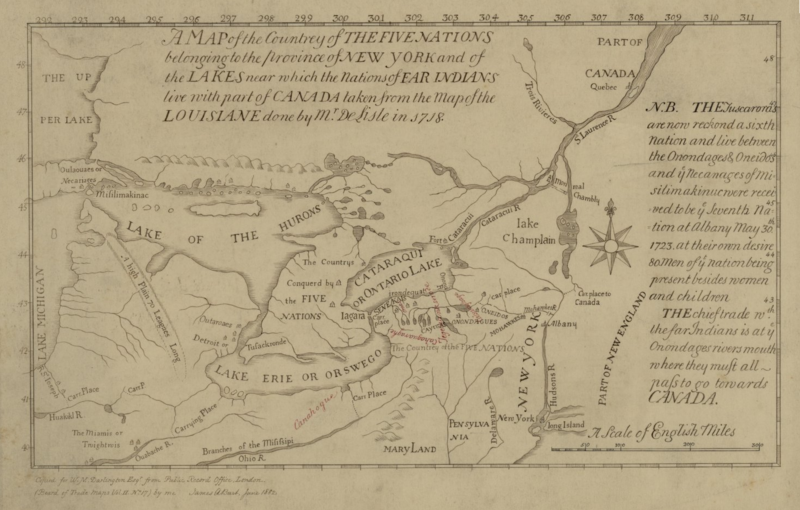The Iroquois Confederacy
The indigenous nation to which our young canoeist belonged is the Seneca Nation, the most populous Iroquois-speaking nation within a Confederacy of First Nations1 called the Haudenosaunee.
The name of this Confederacy is an Iroquois word meaning People of the Longhouse or People who build the house. It is meant to convey a loose union of five national fires of the Five Nations stretched across Iroquoia like the central heaths of a communal dwelling.2
 The Haudenosaunee originally consisted of five Iroquois-speaking nations that inhabiting lands south and east of lake Ontario. They were later to become Six Nations as a related Iroquois nation, the Tuscarora were admitted into the Confederacy in the early 1700s. This map shows the approximate boundaries of the original Five Nations of the Haudenosaunee (circa 1720. Source: Wikipedia).
The Haudenosaunee originally consisted of five Iroquois-speaking nations that inhabiting lands south and east of lake Ontario. They were later to become Six Nations as a related Iroquois nation, the Tuscarora were admitted into the Confederacy in the early 1700s. This map shows the approximate boundaries of the original Five Nations of the Haudenosaunee (circa 1720. Source: Wikipedia).
Linguistically, the Six Nations are members of the Iroquois-speaking peoples of the North Eastern part of North America which included several other peoples including the Neutrals and the Huronian Wyandot peoples. However, in the Confederacy, each of the six nations spoke a distinct dialect of Iroquois.
The lands of the Haudenosaunee
Geographically, the Haudenosaunee lived in territories that were defined loosely from Lake Ontario south to the area known today as Pennsylvania and east to what is today known as the Hudson River. From west to east, they controlled the lands from just east of the Niagara River along the southern coast of Lake Ontario up to the St. Lawrence River. This is roughly 141,000 square kilometers or 54,000 square miles. This is an immense territory for peoples that numbered barely 12,000.3
 Topographically, the lands of the Haudenosaunee were rolling hills, woodlands, meadows and deep valleys some of which included long narrow lakes. Further east and north the land became rocky and mountainous as it formed the southern end of the great Canadian Shield. Except for the Adirondack Mountain area, these lands where very fertile and very suitable for agriculture while abundant wildlife provided game for winter hunting. The natural beauty and exquisite natural formations made this area unique but also immensely defensible. This map from 1730 shows lands of the Six Nations (Date: 1730. Source: Wikipedia from The Darlington Collection).
Topographically, the lands of the Haudenosaunee were rolling hills, woodlands, meadows and deep valleys some of which included long narrow lakes. Further east and north the land became rocky and mountainous as it formed the southern end of the great Canadian Shield. Except for the Adirondack Mountain area, these lands where very fertile and very suitable for agriculture while abundant wildlife provided game for winter hunting. The natural beauty and exquisite natural formations made this area unique but also immensely defensible. This map from 1730 shows lands of the Six Nations (Date: 1730. Source: Wikipedia from The Darlington Collection).
On the far west was the great Onguiaahra or Jaonniaka-re, the powerful cataract, today called Niagara Falls, which our Seneca youth knew was the source of that strong current at the mouth of the river. These lands near the cataract were not Seneca lands but were inhabited by the Iroquois-speaking Wenrohonon or Wenro peoples. They were later to become extinct as a distinct nation and absorbed into the Haudenosaunee. Across the cataract lived the Atiquandaronk or more accurately the Onguiaahra who, although Iroquois-speaking managed to remain neutral between the powerful Huron peoples of the north and the Haudenosaunee of the east and south. The French subsequently called them the Neutrals due to this peaceful coexistence with two warring confederacies. Further west was the Erie peoples who due to fighting during the Beaver Wars was decimated and absorbed into the Haudenosaunee, primarily the Seneca.
Travelling east of Onguiaahra, an Iroquois would encounter the large fertile flatlands of tall grasses, forests and streams before entering the undulating rolling hills and very deep valleys that terminating in lakes seemingly carved out of the earth by a great hand. Beyond these lakes were more fertile lands leading to the hills and rugged mountains of the Precambrian rock of the Canadian Shield. Their territory ended at a large river that began in the north near the St. Lawrence river and ended in the Atlantic Ocean.
The plains, highlands, deep valleys and lakes created a unique environment for the Six Nations that was at the same time isolated yet accessible. The meadows of the western flatlands were ideal for agriculture and for the Seneca who inhabited these lands it was ideal for their staple crops of maize, beans and squash known as the “Three Sisters”. The woodlands were filled with large and small game animals such as deer and beavers. The deer provided meat year round and skins that make durable clothing. Abundant edible wild plants provided fruits and berries. It was a good land and supported a population with the largest towns then known by the early explorers and settlers from Europe.
The constituent nations of the Haudenosaunee
The Haudenosaunee consisted of five original nations and another nation which joined later.
The Seneca (Onödowáʼga:) which means The People of the Great Hill were of the largest of the nations with one of the largest territories. The Great Hill was Nundawao as we saw in the first topic. They were keepers or defenders of the Western Door, the western border of the territory.
Next to them were two much smaller nations - the Cayuga (Gayogo̱hó:nǫ’) or the People of the Great Swamp and the Onondaga (Onöñda’gaga) or The Keeper of the Hill or Keepers of the Central Fire. They were responsible for providing the central meeting place (or capital) for representatives of the other nations.
Further east were the larger territory of the Oneida or People of the Standing Stone which was to have a chunk carved out for the Tuscarora.
Finally, the nation inhabiting the largest territory and arguably the most powerful of the nations were the Mohawk (Kanienʼkehá꞉ka) or Keeper of the Flint. Flint was very important for weaponry and making fires which they obtained from the Mahican and other peoples beyond the large river which formed their eastern boundary. The Mohawks were also known as the Kanienʼkehá꞉ka or Keeper of the Eastern Door as they protected the Confederacy from eastern threats.
The Confederacy was later joined by the Tuscarora (Skarù:ręˀ) or Hemp Gatherers as they were known to wear shirts made from the hemp plant. Land was carved out for them from the Oneida and Onondaga lands.
Later I will discuss how the Confederacy came into being. But by the mid 1700s, the Haudenosaunee were a well defined - and well known - union of First Nations who shared a common language, culture and identity. it gave the Confederacy strength and cohesion which allowed them to win battles with much larger foes, at times the French, the Dutch and the British.
How was the Confederacy affected by European Wars?
This is a very long and complicated story, but the short of it is that the Europeans eventually forced the Confederacy to make peace with these greater powers. By mid-18th century, already demoralized and diminished by warfare and imported diseases, the last blow came during the American Revolution when the British were defeated by American armies. As the Confederacy sided with the British in the struggle, their hold onto their territories became untenable. Pressure from eastern settlers, overt persecution and a promise of land and protection amongst the British for their loyalty made most peoples of the Haudenosaunee make the choice of leaving their lands to settle in Upper Canada.
The Americans entered into several treaties with the Onondaga, Seneca and Tuscarora some of whom stayed in New York while the remainder moved up into Upper Canada onto lands granted to them by the British authorities. However, all their ancestral territories, except reservations, were lost to the American settlers and New York State. Americans saw their lands as ideal for settlement and waves of settlers from New England and Europe carved out towns and villages, staked out farms and for the most part obliterated any evidence that a great people had lived there.
The British granted territories for the Six Nations in Upper Canada including a large territory six miles deep along both banks of the Grand River as well as an additional territory near the Bay of Quinte. Mohawks who had converted to Catholicism by French missionaries had earlier settled in French Canada near present day Montreal and had fought alongside them against the British during the Seven Years War.
So after the 1770s, the Haudenosaunee lived in three territories in British North America, reservations in New York State as well as additional territories in Western United States. The great Confederacy was overtaken by the powerful armies of the Europeans and the incessant need for lands to sell to settlers, industrialists and a general westward push of the United States. Yet today the Haudenosaunee continue to exist and are beginning to assert themselves again and regain their culture and identity.
Footnotes
-
I use the common term “First Nations” to refer to the original inhabitants of North America, as opposed to “Indians” which are a people from India. Other terms are Amerindians, North American Indians, Indigenous Peoples, and others all of which are basically interchangeable. But “First Nations” is the personal choice of the peoples who were in North America before the arrival of Europeans. ↩
-
Richter. People of the Long House, Pg. 30. ↩
-
Encyclopedia Britannica Online at Iroquois Confederacy. Retrieved September 8, 2021. ↩